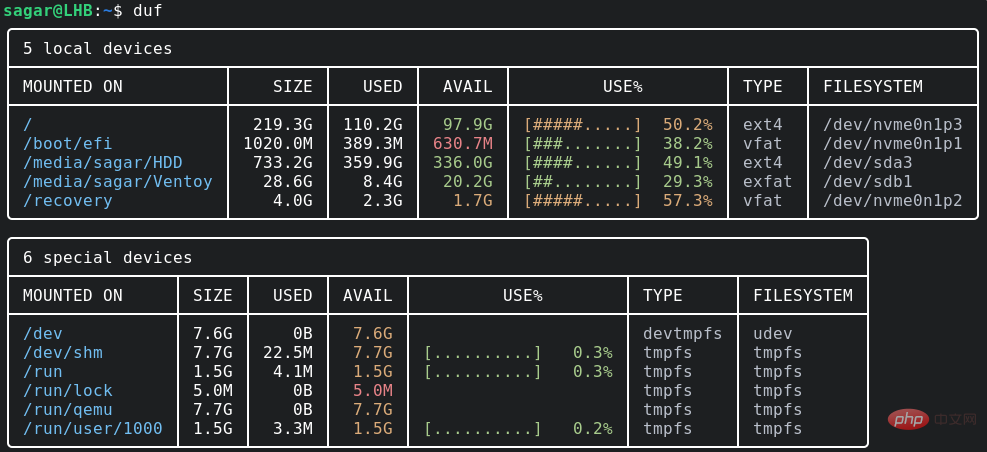 Operation and Maintenance
Operation and Maintenance
 Linux Operation and Maintenance
Linux Operation and Maintenance
 What should I do if Linux does not have the duf command?
What should I do if Linux does not have the duf command?
What should I do if Linux does not have the duf command?
Solution: 1. Use wget command to download the installation package of duf command from GitHub, the syntax is "wget https://github.com/muesli/duf/releases/download/v0.8.1/duf_0.8.1 _linux_amd64.deb"; 2. Use the dpkg command to install the duf command, the syntax is "dpkg -i duf_0.8.1_linux_amd64.deb".

The operating environment of this tutorial: Ubuntu 18.04 system, Dell G3 computer.
For analyzing disk usage, there are two very useful commands: du and df. Simply put, the functions of these two commands are as follows:
du command: It is the abbreviation of the English word disk usage and is mainly used to check how much disk space is occupied by files and directories;
df command: It is the abbreviation of the English word disk free. It is mainly used to check how much space is used on the disk, how much space is left, etc.
Especially when your disk is full, the combination of these two commands is very useful.
However, these two commands are separate after all. It would be great if they could be integrated. After all, they are the same type of commands.
Don’t mention it, someone actually integrated these two commands. It is: duf command!
duf is a cross-disk usage breakup tool written in Golang. It can output disk usage in a table (adaptive) form, and can also sort the results according to needs. It is very useful. convenient! The
duf command displays the disk space utilization, as shown in the following figure:

The result output of the duf command is more readable A structured way to examine system space.
The display is easy to read, right? Today we will share how to install and use the duf command in Linux.
Installing duf
Taking Ubuntu as an example, we cannot directly use the apt-get command to install it and need to install it manually.
First, download the duf command installation package from GitHub:
wget https://github.com/muesli/duf/releases/download/v0.8.1/duf_0.8.1_linux_amd64.deb
Then, use the dpkg command to install
dpkg -i duf_0.8.1_linux_amd64.deb
In addition, you can also install it according to its instruction manual, The address is: https://github.com/muesli/duf
Usage example of duf
Use duf to check disk usage and free space
You can use the duf command directly without adding any options, which will display a list of installed devices:
dnf

View specified devices
You can use duf to list one or more devices at the same time. You only need to specify the path where the port or device is installed:
duf
See the following example:
duf

duf utility provides various options so that you can filter the output and obtain the expected results.
For example, you can use the --only option to only display specific devices:
duf
For example, if we want to list local devices, we can use the following command:
duf --only local

If you want to view a certain file system, you can use the --only-fs option. For example, to view tmpfs (temporary file system), you can use the following command:
duf
You can use the --sort option Sort the output results based on size, usage, etc. For example:
duf
If you like the output in json format, you can use the --json option:
duf
If you want to save the results in a text file, you can redirect the results:
duf --json > duf.json
Related recommendations: "Linux Video Tutorial"
The above is the detailed content of What should I do if Linux does not have the duf command?. For more information, please follow other related articles on the PHP Chinese website!

Hot AI Tools

Undresser.AI Undress
AI-powered app for creating realistic nude photos

AI Clothes Remover
Online AI tool for removing clothes from photos.

Undress AI Tool
Undress images for free

Clothoff.io
AI clothes remover

AI Hentai Generator
Generate AI Hentai for free.

Hot Article

Hot Tools

Notepad++7.3.1
Easy-to-use and free code editor

SublimeText3 Chinese version
Chinese version, very easy to use

Zend Studio 13.0.1
Powerful PHP integrated development environment

Dreamweaver CS6
Visual web development tools

SublimeText3 Mac version
God-level code editing software (SublimeText3)

Hot Topics
 deepseek web version entrance deepseek official website entrance
Feb 19, 2025 pm 04:54 PM
deepseek web version entrance deepseek official website entrance
Feb 19, 2025 pm 04:54 PM
DeepSeek is a powerful intelligent search and analysis tool that provides two access methods: web version and official website. The web version is convenient and efficient, and can be used without installation; the official website provides comprehensive product information, download resources and support services. Whether individuals or corporate users, they can easily obtain and analyze massive data through DeepSeek to improve work efficiency, assist decision-making and promote innovation.
 How to install deepseek
Feb 19, 2025 pm 05:48 PM
How to install deepseek
Feb 19, 2025 pm 05:48 PM
There are many ways to install DeepSeek, including: compile from source (for experienced developers) using precompiled packages (for Windows users) using Docker containers (for most convenient, no need to worry about compatibility) No matter which method you choose, Please read the official documents carefully and prepare them fully to avoid unnecessary trouble.
 BITGet official website installation (2025 beginner's guide)
Feb 21, 2025 pm 08:42 PM
BITGet official website installation (2025 beginner's guide)
Feb 21, 2025 pm 08:42 PM
BITGet is a cryptocurrency exchange that provides a variety of trading services including spot trading, contract trading and derivatives. Founded in 2018, the exchange is headquartered in Singapore and is committed to providing users with a safe and reliable trading platform. BITGet offers a variety of trading pairs, including BTC/USDT, ETH/USDT and XRP/USDT. Additionally, the exchange has a reputation for security and liquidity and offers a variety of features such as premium order types, leveraged trading and 24/7 customer support.
 Ouyi okx installation package is directly included
Feb 21, 2025 pm 08:00 PM
Ouyi okx installation package is directly included
Feb 21, 2025 pm 08:00 PM
Ouyi OKX, the world's leading digital asset exchange, has now launched an official installation package to provide a safe and convenient trading experience. The OKX installation package of Ouyi does not need to be accessed through a browser. It can directly install independent applications on the device, creating a stable and efficient trading platform for users. The installation process is simple and easy to understand. Users only need to download the latest version of the installation package and follow the prompts to complete the installation step by step.
 Get the gate.io installation package for free
Feb 21, 2025 pm 08:21 PM
Get the gate.io installation package for free
Feb 21, 2025 pm 08:21 PM
Gate.io is a popular cryptocurrency exchange that users can use by downloading its installation package and installing it on their devices. The steps to obtain the installation package are as follows: Visit the official website of Gate.io, click "Download", select the corresponding operating system (Windows, Mac or Linux), and download the installation package to your computer. It is recommended to temporarily disable antivirus software or firewall during installation to ensure smooth installation. After completion, the user needs to create a Gate.io account to start using it.
 Ouyi Exchange Download Official Portal
Feb 21, 2025 pm 07:51 PM
Ouyi Exchange Download Official Portal
Feb 21, 2025 pm 07:51 PM
Ouyi, also known as OKX, is a world-leading cryptocurrency trading platform. The article provides a download portal for Ouyi's official installation package, which facilitates users to install Ouyi client on different devices. This installation package supports Windows, Mac, Android and iOS systems. Users can choose the corresponding version to download according to their device type. After the installation is completed, users can register or log in to the Ouyi account, start trading cryptocurrencies and enjoy other services provided by the platform.
 gate.io official website registration installation package link
Feb 21, 2025 pm 08:15 PM
gate.io official website registration installation package link
Feb 21, 2025 pm 08:15 PM
Gate.io is a highly acclaimed cryptocurrency trading platform known for its extensive token selection, low transaction fees and a user-friendly interface. With its advanced security features and excellent customer service, Gate.io provides traders with a reliable and convenient cryptocurrency trading environment. If you want to join Gate.io, please click the link provided to download the official registration installation package to start your cryptocurrency trading journey.
 How to Install phpMyAdmin with Nginx on Ubuntu?
Feb 07, 2025 am 11:12 AM
How to Install phpMyAdmin with Nginx on Ubuntu?
Feb 07, 2025 am 11:12 AM
This tutorial guides you through installing and configuring Nginx and phpMyAdmin on an Ubuntu system, potentially alongside an existing Apache server. We'll cover setting up Nginx, resolving potential port conflicts with Apache, installing MariaDB (







